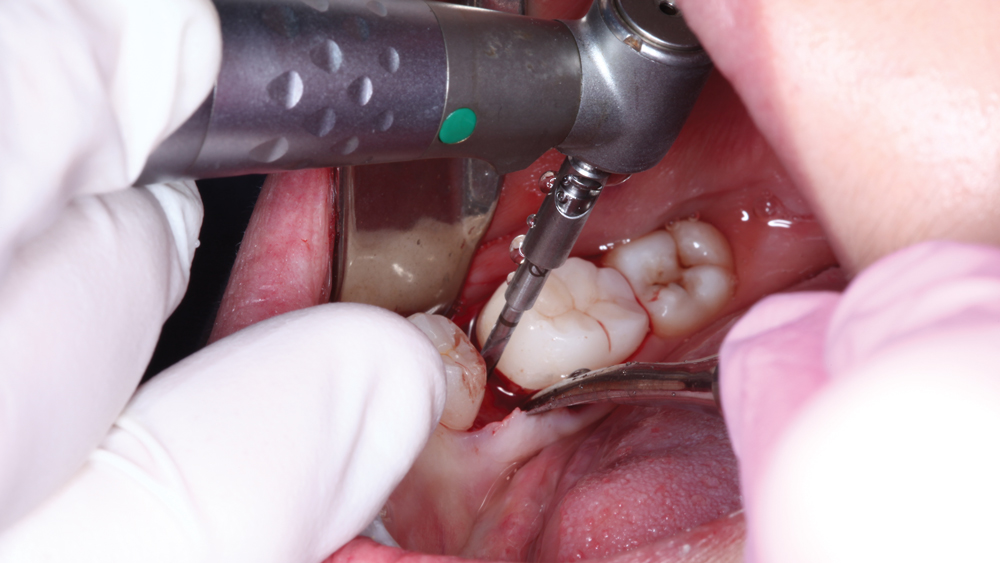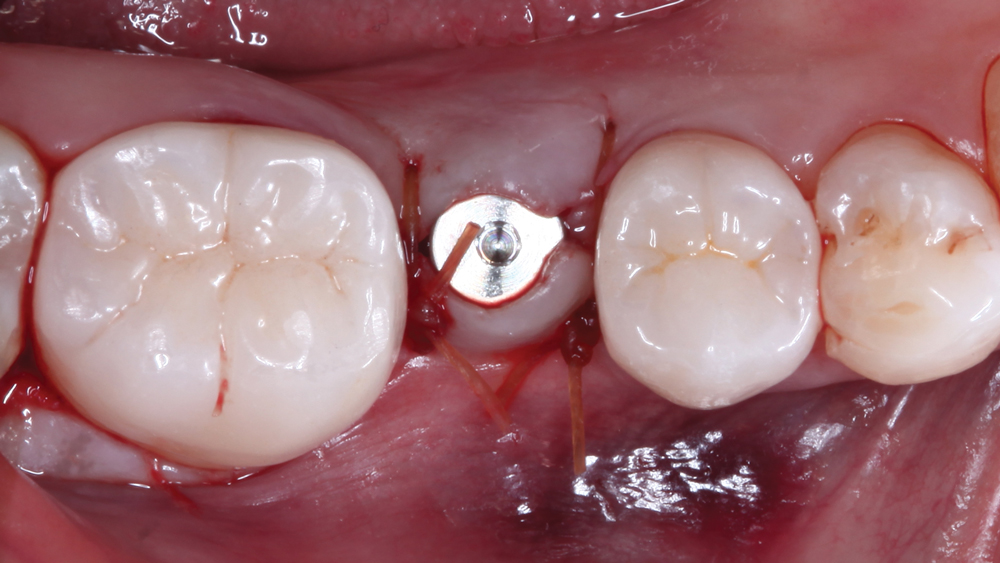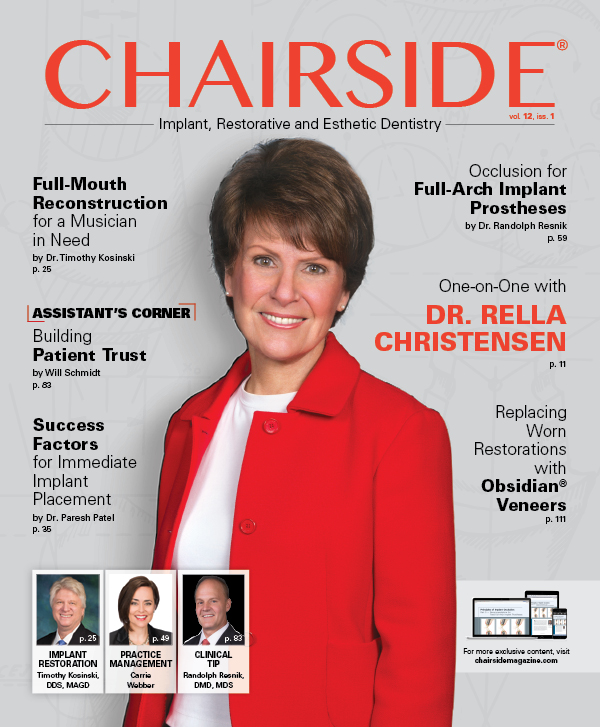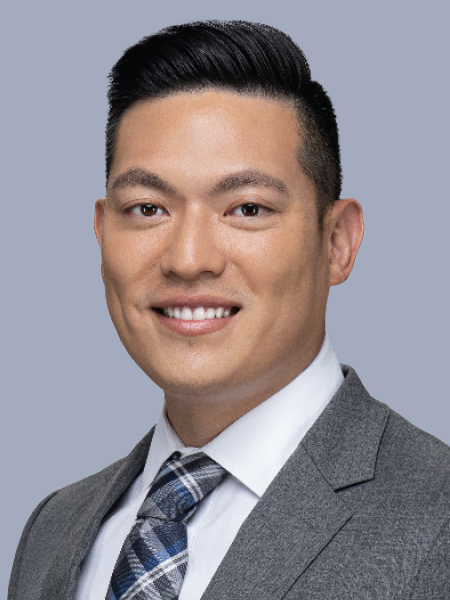My First Implant with Justin Chi, DDS, CDT
Note: The Hahn Tapered Implant System is now known as the Glidewell HT Implant System
Dr. Justin Chi is a clinical research associate at Glidewell Dental, where he has quickly emerged as a clinical expert on digital workflows. Putting the latest tools into use on a daily basis, Dr. Chi is able to offer tips and best practices for dentists seeking to become more efficient through digital impressions, in-office milling and other digital technologies. With his clinical experience now including implant placement, he’s detailing the steps he took to prepare for his first implant case and sharing what he has learned along the way.
Chairside® magazine: What kind of training did you do to first get into implantology? Were implants part of your curriculum at USC?
Dr. Justin Chi: In dental school at USC, we didn’t have an official surgical implant program or curriculum. We did shadow a perio resident for a couple of cases. We would take the diagnostic impressions, and we would wax up the tooth in the edentulous space. From that wax-up, we would create a surgical guide and provide that to one of the perio residents. We would also assist during the procedure.
CM: What about your training post-dental school?
JC: My more recent training was with the Misch International Implant Institute™. I went through Surgical Sessions 1 and 2, and the courses were excellent. They provided the didactic information and hands-on exercises that really showed me how to get started. It is all about the planning and knowing what to look for, identifying the anatomical structures, taking the right preoperative impressions and intraoral views, and assessing the patient’s health, X-rays and CT scans. Once you incorporate all of this information in the planning stage, then you can go about the implant placement in the best way. That’s what the course provided for me. The hands-on portion, which included practicing on models and pig jaws and learning the protocol for the Hahn™ Tapered Implant Surgical Kit (Glidewell Direct; Irvine, Calif.), was particularly helpful.

CM: With Misch Implant Institute courses, they seem to emphasize the need for a blueprint when you have an implant case.
JC: Exactly. It’s all about the planning. Now that you’re dealing with an edentulous space, you have to plan in all directions. You have to understand the occlusion. You have to know the condition of the adjacent teeth and, of course, the status of the bone and soft tissue. You’re factoring all of that in, and that’s more to consider than with a tooth-borne restorative procedure.
CM: The considerations certainly do change. Has implant placement been a long-standing goal of yours?
JC: Definitely. Being able to place an implant allows us to offer patients a tooth replacement that’s most true to the natural tooth form. It helps preserve bone and gives them the ability to clean around the implant and the adjacent teeth. It’s just ultimately a healthier option. So, I think it’s really important that all dentists are able to do straightforward, single-unit implant placement.
Being able to place an implant allows us to offer patients a tooth replacement that’s most true to the natural tooth form.
CM: What kind of case did you choose for your first implant?
JC: It was a case where the patient was missing tooth #30, which she said was removed in 2008 and restored with a bridge from #29–31. In 2011, she went to a dentist who cut through the pontic and tried doing Invisalign® (Align Technology, Inc.; San Jose, Calif.) to push the teeth forward to close the space. The patient didn’t think that the strategy was working out the way it was intended. She stopped the orthodontic treatment and came to me with this problem.
Dr. Siamak Abai, director of clinical R&D for the Implant division at Glidewell Dental, removed the old crowns on teeth #29 and #31 and replaced them with BruxZir® Anterior crowns. We planned out the case together, and I was able to use the information I had learned from the Misch courses, backed by Dr. Abai’s guidance. It was great to have someone who’s experienced in implantology verify what I was thinking.

CM: Was Dr. Abai there for the implant placement as well?
JC: He was, and he served as support in addition to being the photographer. Having him around helped a lot. The week before he had completed a similar case, and I observed what he did at each step.
CM: Because your patient had some ortho, did that pose any challenges?
JC: Tooth #31 was just a little bit tilted over. The intraoral situation wasn’t too unusual, though, considering the posterior teeth distal to an edentulous space typically will shift over. The space now is almost like a space for a premolar, so we’re going to have to compromise a little bit in that final crown design.
CM: How much healing time are you planning for, and what is the final restoration going to be?
JC: We decided on four months. Most likely, it’s going to be a BruxZir screw-retained crown. Screw-retained has some advantages regarding placement technique, and if for any reason you need to remove the crown you can do that relatively easily.
Screw-retained has some advantages regarding placement technique, and if for any reason you need to remove the crown you can do that relatively easily.
CM: Did anything surprise you about the procedure?
JC: I was not surprised in a negative way at any point. I was more surprised at how straightforward it was. Really, once you open the flap and expose the bone, you’re making sure the ridge is level and no modifications need to be done there. Then, you just go through the steps of the Hahn surgical kit. I was pleasantly surprised with the process.

CM: How did you feel after completing the procedure?
JC: Well, partly I felt relief. I was nervous to go through it, but it was exhilarating. I was excited that I successfully placed the first implant, and when I was finished I just felt like, “Wow, that was it?” The actual procedure doesn’t take a lot of time because the time for the procedure is spent beforehand, in the planning phase. Having practiced with the Hahn kit on a typodont, I found that using it on the patient was virtually the same thing. You’re just going down the line and following directions. If you follow the layout of the kit, it takes you from A to Z in the easiest way possible.
CM: The Hahn kit acts as a road map right there on your tray.
JC: Pretty much. Everything is provided for you.
CM: How did the patient react?
JC: The patient was extremely comfortable throughout the procedure. The recovery period was a lot easier than she had expected. Of course, she was nervous beforehand, but she was very pleased with it.
CM: Do you already have your next implant case lined up?
JC: I have a consult coming up where I think we may have a situation that calls for an extraction and immediate placement.
CM: What else do you have your sights set on — mini implants or maybe a full-arch case eventually?
JC: I’ve always thought implant-supported dentures were such a great option for fully edentulous patients. My grandfather wore dentures, and when they didn’t fit well he would go without them. With implants, being able to have that support and retention for the appliance can improve the quality of life for these patients significantly. I want to be able to offer that.
CM: What steps would you suggest for other doctors who are looking to make the transition into implantology?
JC: I would recommend seeking out the mentorship of others. That’s why we go to these courses. You’re learning from people who have seen all of these different scenarios and are able to provide you with the most relevant information. With the Misch Implant Institute, they train for everything from simple to complex cases. There are also so many excellent resources online. Even before my Misch training, I went on glidewelldental.com and watched YouTube videos, including our “Chairside Live” episodes, because it’s really about seeing that information and those procedures over and over again.
CM: The right courses, as well as immersing yourself in available resources, are key.
JC: The courses do help you feel more comfortable and confident. As long as you build that foundational knowledge, any dentist can successfully place implants.
As long as you build that foundational knowledge, any dentist can successfully place implants.
CM: Excellent. Thank you for chatting with us, Dr. Chi.
JC: Thank you.



